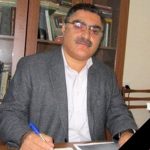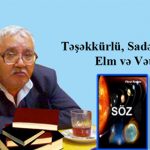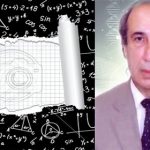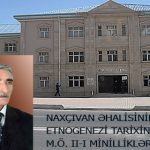The Land of Inimitable Monuments
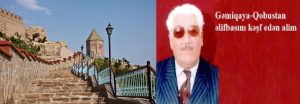
The Prophet Noah’s grave was found
With the joy of this news I went to Nakhchivan in the end of December last year. Together with the organizers of the international “Gamigaya” expedition: well-known academicians, deputies, the chairman of Nakhchivan department of the Azerbaijan NAS (National Academy of Sciences) Ismail Hajiyev and the rector of the Nakhchivan State University named after Y.Mammadaliyev Isa Habibbayli, we walked up to the high slope near the old fortress wall of the city. The grave of the Prophet Noah, who saved the mankind from the Deluge, was on this slope. Looking at our big grand’s simple grave I thought that it is some kind of heroism to save and protect the grave of such man of genius, the first historical person of Azerbaijan during thousands of years. And this hero is Azerbaijan nation.
The figures expressing the long period passed in front of my eyes: Egypt pyramids considered to be more than 4000 years old, “Bilgamis” epos – more than 5000 years old remain in our side of history. Whereas, 12-13 thousand years separate us from the Deluge, which happened earlier than the last boulder-period. (Sometimes it is given 6-7 thousand years considering it the “regional deluge”. But there is no need in Prophet Noah and his ark in the “regional deluge”. Actually, to speak of the “regional deluge” is to run counter to the Qur’an and the Bible).
Our grand Noah deserved turning into legend owing to inaccessible antiquity of his ark and his grave. Noah’s principal heroism is the fact of being a new – 2nd founder of the civilization. It is also natural that his grave turned into sacred shrine during millenniums. During the last period of atheism within the Russian-Soviet Empire, which Azerbaijan also was a part of, spiritual feelings of men were insulted, mosques, churches, holy places, the ecclesiastics’ graves were destroyed. Prophet Noah’s grave also was destroyed, and eliminated among holy places at that period. But by a lucky chance, though the tomb was destructed, the prophet remained untouched, his grave was safe.
In connection with it academician Isa Habibbayli said:
– The canvases of Bahruz Kangarli, the first professional painter of Azerbaijan, helped us to find Noah’s grave. A painter of genius created 6 paintworks on the subject of “Noah’s Grave” in the beginning of the XX century in 1918-19. Just those paintworks showed us the place of our prophet’s sacred grave. Those who were forced to demolish the tomb stopped 2 bricks remaining to the first base, and covered up the octagonal tomb with soil and rocks, thereby losing the trace. Probable, Prophet Noah’s tomb was repeatedly renovated by people during years. After finding the grave we cleaned its surface and its surrounding of dust and soil. On the special instructions of Vasif Talibov, the chairman of the Supreme Soviet of Autonomous Republic of Nakhchivan a new, a fine tomb will be constructed on Noah’s grave in the short run. Sacred grave of our prophet grand, who saved the mankind of the Deluge, will turn into a sacred shrine for the entire world again and forever.
NAKHCHIVAN IS A LAND OF INIMITABLE MONUMENTS
Among these monuments Gamigaya is the most significant. Within scientific-literary groups the subject of “Nakhchivan-Gamigaya-Noah’s Ark” has turned into the point of large discussions and debates. Today that subject is of universal significance, and has rather political character than scientific. The talks about the worldwide deluge and salvation of human generation (and other living things) by means of Noah’s ark had gradually turned into the worldwide legend. Almost in every country the local variants of this legend were created. As well as in Kazakhstan, Altai territory, Korea, Japan, China, India, Syria, Germany, Italy, Mexico, Guatemala, Peru and in other countries they point at some mountain and say: “Noah’s ark had stopped on this mountain”.
But what differs the original Gamigaya in Nakhchivan from other “Gamigayas”? Are such differences available? Of course, they are. Consideration of the main sources is needed for determination of those differences.
The 1st source – is our sacred book Gur’an, the 2nd is the Bible, the 3rd is “Bilgamis” and the 4th as well as the oldest, the most initial source is: Gamigaya-Gobustan paintings and scripts.
One of translators of the Gur’an, late academician Ziya Bunyadov wrote: “The fame of the Judi mountain (one of the first Gamigayas- A.F) mentioned in the Gur’an is connected with well-known Mesapotamia legend about moor of the Noah’s ark on this mountain”. (See: Quran.Qeydlar va sharhlar. Baku, 1992. pg.674.) Nakhchivan-Gamigaya is nearer to the Judi mountain (in the territory of Syria) than other “Gamigayas” in the world. Turkish scientist Ahmed Ergoz calls Judi a mountain chain. (See. his “Nuh tufanı”, Izmir, 1990). If to base on this opinion, Gamigaya in Nakhchivan is the highest peak on the north of that chain. Moor of Noah’s ark just in this peak (4500 m) has to be considered natural.
This is the 1st main source – the main difference that cannot be compared with any other “Gamigaya”. The 2nd main source is the Bible. The world scientists consider Bilgamis a historical person. He – Bilgamis idealized the events that happened to him (the IV millennium B.C) and that he heard, even the events occurred some millenniums before him, and ordered to write them on very high, massive wall of Uruk city, which was found and governed by him:
“He used to know every secret,
he used to see everything,
He informed us
about the Big Deluge.
He walked long ways,
and finally got tired,
He engraved on a massive rock all that happened to him
Then he fenced it and called it Uruk
(Bilgamıs.1985. s.8. Translated in Azeri by Ismayıl Valiyev)
This is written information that existed some millenniums earlier than the holy books. It is talked here not about “regional deluge”, but just about the worldwide Deluge.
When looking through the names described in “Bilgamıs” it is revealed their parallelism with Nakhchivan and with Azerbaijan in whole. That is, for example, Hachadagh- the mountain of Nisir Nasirvaz, Sharur (Sharur [ʃᴂrur]), Shuruppıq, Siduri (Saduri- Sadarak), Kish, as a name of village and river, Dilmun (Dilman village in Aghsu, Kinqir (Kangar), Quchi (Qutqashen), Dimmuz (Dumuz), Utu, Bel (Belet), Ubar (Abar), Tutu, Aktu, Etana (Oteke),Ishtar (Sevit- the Sun’s daughter), Shamkhat (Shamkhat-sham woman –Shaman woman), Kur (the Kur river), Utkarishta (the villages Utuk, Otka-Adna) and etc. None of the Gamigayas in the world has such parallels together with its surroundings.
And this is the 3rd main source and the main difference. The world admits that there is not any written source before “Bilgamıs”.
As a result of the researches conducted during recent 35 years by the author of these sentences it became clear that “Gamigaya-Gobustan paintings and rock scripts existed some thousands of years ago than “Bilgamis”, and they can be read clearly at present as well. Our respected scientists, the academicians: Budag Budagov, Isa Habibbayli, Ismayil Hajiyev, Mirabbas Gasimov, corresponding member of the ANAS Vali Aliyev, the doctors of philosophy, the professors Gara Mashadiyev, Fanah Khalilov, Abbas Seyidov,Gadir Gadirzadeh, Aida Feyzullayeva, Elmaddin Alibayzadeh, Bayram Allahverdiyev, Ajdar Aghayev and others state that Gamigaya-Gobustan scripts are confident history. The author of these sentences revealed the pictures of the Noah’s Ark among Gamigaya-Gobustan paintings. (See: his book “The Noah’s Ark and the Gamigaya-Gobustan Alphabet”, B.2005, pg. 81-102, in Russian).
These paintings are the first findings in the world as yet. And this fully confirms that the legend of Gamigaya and the Noah’s Ark is directly connected with Azerbaijan land – Nakhchivan-Gamigaya. And it is the 4th main source and the main difference.
These 4 sources, 4 main differences prove that, the legend of the Noah’s deluge spread to all of the world just from Azerbaijan – from Nakhchivan. But some authors basing on “armenian” variant of this legend, put forward its connection with Armenians, and some just because of that reason say that the legend of the Noah’s deluge and Gamigaya are a fiction. Even they allege that the “Noah’s Ark” and the idea of its connection with Nakhchivan “was engendered from Armenian sources”, and they see the “way out” in refusal of this “idea”. All of these statements do not have base and foundation.
The academician Ziya Bunyadov wrote: “In ancient Armenian legends there is not any information about stay of the Noah’s Ark on a mountain. The legend about stay of the Noah’s Ark on the pick of the Masis (Aghri-Ararat- A.F) mountain started occurring in Armenian literature just in the XI and XII centuries” (See: Quran. Qeydlar va sharhlar. pg. 674).
Therefore, Armenians during some hundreds of years spoke of moor of the Noah’s Ark on the pick of the Masis (Aghri) mountain. When they saw that the Noah’s Ark is connected with Nakhchivan – with Gamigaya, as proved by Azerbaijani scientists, they started misappropriating Nakhchivan, as they do with Garabagh and other Azerbaijan territories. If these robber Armenians want to capture with impudence, to “make Armenian” everything that we have, should we abandon our moral and material values?! “Relating to Armenians” the idea that “Nakhchivan is Noah’s land” without any scientific, historical-religious basis is showing indulgence towards Armenians.
According to some people’s opinion, as though, “after creation of human society there did not happen such event as complete flooding of the earth”. That idea arises from leaving out of account our sacred book Qur’an, the Bible, “Bilgamis”, and finally, Gamigaya-Gobustan paintings. Apparently, such people are unaware of new scientific sources as well. In the Qur’an, the Bible and “Bilgamis” there is not a word about any “regional deluge”. Such authors should read the Qur’an more attentively again. Physicist of genius A. Einstein wrote: “It is impossible to believe in science that is not based on religion”.
We should note again that the history, scientific roots of the legend about Gamigaya, Noah’s Ark and Noah’s grave. The idea of that Nakhchivan is Noah’s land belongs to Azerbaijan people. This idea had turned in legend end spread to the entire world. It was confirmed again by the members of the international “Gamigaya” expedition which spent its first mobile conference in Nakhchivan – Gamigaya in 2005.
Ajdar Farzali
The “525th Newspaper” 16.02.2006
Translated by Kamala Amiraslanova



